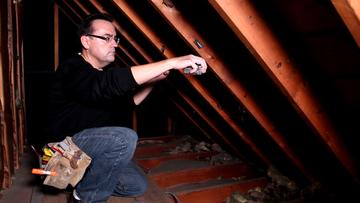
Getting Familiar with the Attic
Homeowners are always focused on living rooms, bedrooms, kitchens, and basements, but they always seem to overlook the attic. In reality, the attic is an aspect of the house that needs to be examined and maintained since it has a large effect on a house's comfort and energy efficiency. For example, if your attic isn't insulated properly you can lose up to 60% of your wintertime heat. Moving forward we will dive into the main necessities in an attic.
First up to bat in the attic is its framing. Attics usually come with two types: rafters and roof trusses. Most old houses and some new ones are framed with rafters. “Rafters” means the framework is made from lumber that goes from the roof's ridge board down to the top plate of the exterior walls. Rafter framing results in bigger attics that can be used as storage spaces or even living spaces. Roof trusses on the other hand uses angled web framing and is much smaller meaning that it shouldn't be used for storage.
Along with the framework you will also want to know what your building envelope entails. Most attics have insulation in the floor which keeps it out of the building's envelope. In other terms it is not included in a house's conditioned space that is heated or cooled. Some attics are conditioned, which means that the insulation is located in between the rafters to keep the attic comfortable when it's extremely hot or cold outside. If you want to remodel an unconditioned attic into a living space, the insulation must be reallocated first to put the attic inside the building envelope.
Ventilation is another aspect of an attic that cannot be ignored. Without it, moisture and heat will build up in the summer, and ice dams can form in the winter. The easiest way to counteract this is to instal soffit vents and ridge vents. Soffit vents run along the eaves of a house while a ridge vent is located along the ride of the house- hence the name. As warm air rises and exits through the ridge vent, an equal amount of cool air is drawn through the soffit vents into the attic. Especially when it's hot out, the surface temperature of your roof can reach temperatures up to 160 degrees Fahrenheit, which heats up the attic and makes rooms directly below the attic heat up as well. A quick, cheap, and simple way to fix this problem is to install an attic fan that will activate as the attic's temperature surpasses a certain threshold.
One last thing to keep in mind is that if the house is older, it is more likely that the attic is also not up to date in quality. Air sealing and insulation may be old and ineffective, so make sure that you upgrade your insulation if needed. This is usually fairly simple since old, existing insulation can be replaced just by inserting new insulation over it. In conclusion, an attic can be used as another room or a storage place, but even if it isn't it still has a huge influence on the overall temperature of the house. An old and deteriorated attic can lead to major temperature fluctuations and pricier electric bills.

